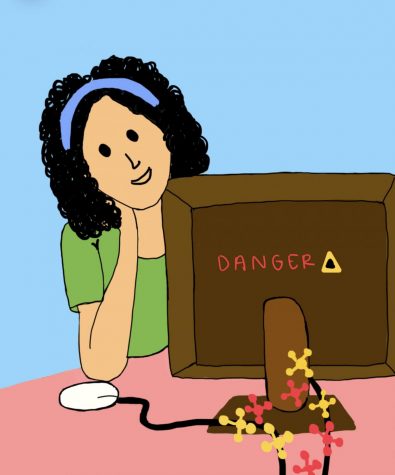The dangers of online friendships amidst the pandemic

The solitude brought on by the global pandemic has students stuck behind their computer screens, which leaves them with only the pixelated versions of their classmates for comfort. As such, many have turned to the online world for company amidst these difficult times. Although the internet may act as a gateway to a socially distanced form of social interaction, it is important to remember the dangers that online interactions and friendships may present.
Arguably the most dangerous form of online interaction, anonymous video chatting, has gained a considerable amount of popularity during the pandemic. The video-chatting platform Omegle is attaining recognition across multiple social media platforms, and it has become a popular way for people to chat with strangers. However, due to the fact that the site is lacking in any legitimate security features, it poses a large risk to students who may use the platform.
A recent investigation done by the BBC revealed sexually explicit videos and live streams being held on the site, many of which featured minors around the ages of seven and eight. Students seeking a late night conversation with a stranger or a quick chat online should be cautious of which websites they choose to use, as well as what they choose to share online. Basic internet safety should also be applied no matter what the case is when it comes to online interactions. Interacting with internet friends is no exception to this rule.
Students have the ability to hide behind their computer screens, and without others present to monitor their speech, there is a greater chance for harassment to take place.
— Alexa Vazquez
Friendships made over the internet can often lead to long lasting connections or bonds through a shared interest, as many find others that share similar hobbies with them over the internet easier than they would face to face. However, friendships over the internet harbor another layer of difficulty: uncertainty. The ability to hide behind a computer screen allows one to conceal information like identity, age and other personal details.
While the internet may be a convenient way for people to communicate, as well as one where judgment based on appearances is cast aside, the level of uncertainty that comes with it is one that students should always remain cautious of. This is especially true when it comes to sharing personal information. If students aren’t sure who they’re communicating with, then it isn’t safe to be sharing information that could endanger both themselves and their well being.
However, pushing uncertainties aside, there is another level of potential danger that comes with having internet friends. According to a recent report released by L1ght, an organization dedicated to monitoring online harassment, there has been a 70 percent increase in cyberbullying during the pandemic. Online harassment is another risk that comes with communicating with internet friends. Due to the inadvertent increase in screen time caused by the pandemic, students are finding themselves communicating with classmates and friends online rather than face-to-face. In a poll by the Crusader, of 448 BVH students collected on April 27, 53.6 percent said that they’ve made new friends over the internet during the pandemic.
It is not much of a stretch to assume that any harassment or bullying students could experience on campus is more than possible to be experienced within the digital realm, as well. Bullying and harassment is, in fact, made easier to execute due to that same factor of uncertainty. Students have the ability to hide behind their computer screens, and without others present to monitor their speech, there is a greater chance for harassment to take place.
These are all dangers that students have been taught from a young age, along with the basic elements of internet safety that came with the introduction of technology. However, with the pandemic leading to an increase in screen time and the ever present isolation of quarantine, students have sought out alternative ways to communicate with others. In doing so, it is now important to remember the risks that come with such forms of communication, as well as how to navigate it safely. In reaching out to each other during difficult times, students should remember now more than ever that their words matter.

Writing can be a ridiculously painful thing to endure, but I think that giving it up would be even worse. After all, who doesn’t like a challenge? I’m...
I am a junior at Bonita Vista High, and a second year staff member on the Crusader. I love being able to meet new people, and having conversations with...


















